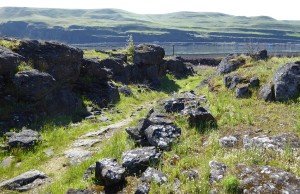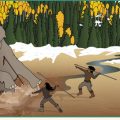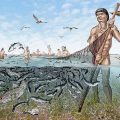The boundary lines that mark the current state of Colorado are artificial and were laid down by non-Indigenous people with no regard for the cultures of the American Indians who had occupied this territory for thousands of years. Within categories of American Indian culture areas Colorado includes portions of three: (1) the Southwest; (2) the Great Basin; and (3) the Great Plains. Listed below are some of the archaeological sites in Colorado which have been dated prior to 6,000 BCE.
Dutton and Selby sites: by 15,000 BCE, Indian people at the Dutton and Selby sites near the present-day town of Wray were hunting (or at least scavenging) camels, horses, and bison.
Lamb Spring: about 11,140 BCE, Indian people at the Lamb Spring site butchered a mammoth.
Mahaffy Cache: about 11,000 BCE, Indian people using Clovis technology left a cache of tools—8 bi-facially flaked knives, a chopping tool, and numerous flakes—at one of their sites. DNA analysis of the protein residue on the tools of the Mahaffy Cache revealed that they had been hunting bear, horse, wild sheep, and camel.
Jones-Miller site: by 9500 BCE, Indian people were using the Jones-Miller (5YM08) bison kill site.
By about 8000 BCE, Indian people at the Jones-Miller site (5YM08) appear to have domesticated dogs. They were also using Hell Gap points.
Lindenmeier site: by 9200 BCE, Indian people using Folsom technology were using the Lindenmeier site for processing bison. In her book The Prehistory of Colorado and Adjacent Areas, anthropologist Tammy Stone reports:
“It appears that the camp space was divided into different activity areas for manufacturing various items from bone, including jewelry. This site demonstrates that Folsom period peoples butchered and ate many different animals including, but not restricted to, bison, although we do not know in what proportions.”
Great Stemmed Basin complex: by 8700 BCE, Indian people were making long-stemmed points with random, collateral, or other flaking patterns. Archaeologists will later call this the Great Stemmed Basin complex.
Beads: by 8700 BCE, Indian people were making very small beads out of oil shale.
Bison hunting: about 8800 BCE, American Indian bison hunters were camping in a small, well-watered valley north of Fort Collins, Colorado. This site was visited on a regular basis by two semi-autonomous groups who cooperated in the bison hunts.
Agate Basin Complex: about 8800 BCE, the Agate Basin Complex appears in Colorado. Archaeologically, this complex appears to be an outgrowth of the Folsom tradition. The projectile points are very long and slender. The shapes range from lanceolate to leaf-shaped and occasionally the points are pointed at both ends.
Olsen-Chubbock site: about 8500 BCE, Indian hunters killed almost 200 buffalo at the Olsen-Chubbock site. The 150 fully butchered animals produced about 60,000 pounds of meat which is enough to feed 50 people for more than 3 months.
About 8200 BCE, Indian hunters using Plainview and Plano tool kits drove a herd of bison into a gully and killed about 200 animals. In his book Prehistory of the Americas, Stuart Fiedel describes it this way:
“A whole herd was apparently surrounded and driven into the steep, narrow arroyo. The animals struggled vainly to escape as others fell on top of them. Those that lay on top of the pile were finished off by the hunters, while the bison trapped beneath them were crushed to death.”
Only a few of the animals at the Olsen-Chubbuck site were butchered. The kill took place in the summer or early fall. It is estimated that 150 to 200 people took part in the hunt.
Hell Gap Complex: about 8500 NCE, the Hell Gap Complex begins. The Hell Gap projectile point appears to have developed out of the Agate Basin points. The Hell Gap points have constricted bases. Anthropologist Tammy Stone reports:
“The constricted base indicates that these points may have had socketed hafts, which is further supported by grinding on the base but not on the lower lateral edges.”
Plainview Complex: about 8200 BCE, the Plainview Complex appeared in Colorado. Archaeologically this complex is defined by lanceolate-shaped projectile points with parallel or slightly convex sides and concave bases.
Foothills-Mountain Complex: about 8000 BCE, the Foothills-Mountain Complex was developed out of a Great Basin adaptation. The leaf-shaped points were roughly made and have ground bases. The points were used in socketed hafts.
Burial: about 7700 BCE, an Indian woman 25-30 years old died and was buried in a flexed position near Gordon Creek. She was covered with red ochre before burial and was interred with her head oriented to the north. Buried with her were a grinding stone, a hammer stone, an end scraper, two small bi-faced stone blades, and three utilized flakes. In addition to the stone tools, the burial goods included two worked animal ribs and a perforated elk tooth. She was 4’11” tall.
Hourglass Cave: about 6620 BCE, the body of a man is buried in the Hourglass Cave.
Bison Hunt: about 6500 BCE, southeast of Kit Carsen, Colorado, hunters stampeded a large bison herd into a dry gully. The herd went off a steep edge and 157 were killed. Three-fourths of the bison were butchered and this meat would have provisioned 100 people for about a month.
Black Knoll Phase: about 6250 BCE, in Northwestern Colorado, the period which archaeologists call the Black Knoll Phase begins. Archaeologists Tammy Stone reports:
“The Black Knoll is characterized by increasing population, evident in the increased number of sites.”
Note: The information in parenthesis following the name of the site is the Smithsonian Designation System. In this system of recording archaeological sites, the first number refers to the state; this is followed by letters which refer to the county; and then a number indicating its order in being recorded. Thus 5LP 10, means that the site is in Colorado (5th state when the states are listed alphabetically), La Plata County (LP), and was the 10th site recorded in La Plata county in the State Archaeologist’s office.



Leave a Reply